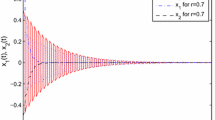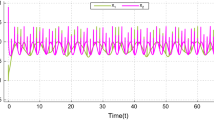Abstract
This paper aims at estimating the domain of attraction of discrete-time impulsive neural networks with impulse input saturation by using Lyapunov function. When an equilibrium point is locally asymptotically stable, we estimate the size of its domain of attraction and then analyze the effects of impulse input saturation. Two numerical examples are presented to unfold the effectiveness of the theoretical results.




Similar content being viewed by others
References
Cohen MA, Grossberg S (1983) Absolute stability and global pattern formation and parallel memory storage by competitive neural networks. IEEE Trans Syst Man Cybernet 13(5):815–826
Grossberg S (1988) Nonlinear neural networks: principles, mechanisms, and architectures. Neur Netw 1(1):17–61
Song Q, Cao J (2008) Dynamical behaviors of discrete-time fuzzy cellular neural networks with variable delays and impulses. J Franklin Inst 345(1):39–59
Yang X, Cui X, Long Y (2009) Existence and global exponential stability of periodic solution of a cellular neural networks difference equation with delays and impulses. Neur Netw 22(7):970–976
Liu B, Hill DJ, Sun Z (2018) Input-to-state exponents and related ISS for delayed discrete-time systems with application to impulsive effects. Int J Robust Nonlinear Contr 28(2):640–660
Li C, Wu S, Feng GG, Liao X (2011) Stabilizing effects of impulses in discrete-time delayed neural networks. IEEE Trans Neur Netw 22(2):323–329
Kaslik E, Sivasundaram S (2011) Impulsive hybrid discrete-time Hopfield neural networks with delays and multistability analysis. Neur Netw 24(4):370–377
Wenlin Jiang (2019) Exponential Lagrange stability for impulses in discrete-time delayed recurrent neural networks. Int J Syst Sci 50(1):50–59
Sowmiya C, Raja R, Zhu Q, Rajchakit G (2009) Further mean-square asymptotic stability of impulsive discrete-time stochastic BAM neural networks with Markovian jumping and multiple time-varying delays. J Franklin Inst 356(1):561–591
Hui Li, Yonggui Kao (2019) Synchronous stability of the fractional-order discrete-time dynamical network system model with impulsive couplings. Neurocomputing 363:205–211
Wenjun Xiong (2018) Stability of singular discrete-time neural networks with state-dependent coefficients and run-to-run control strategies. IEEE Trans neur netw learn syst 29(12):6415–6420
Jinling Wang (2018) A new approach based on discrete-time high-order neural networks with delays and impulses. J Franklin Inst 355(11):4708–4726
Wang X, Park JuH, Zhao G, Zhong S (2019) An improved fuzzy sampled-data control to stabilization of T-S fuzzy systems with state delays. IEEE Trans Cybern 50(7):3125–3135
Li H, Li C, Huang T, Zhang W (2018) Fixed-time stabilization of impulsive Cohen-Grossberg BAM neural networks. Neur Netw 98:203–211
Li L, Li C, Li H (2018) Fully state constraint impulsive control for non-autonomous delayed nonlinear dynamic systems. Hybrid Systems. Elsevier, Nertherland, Nonlinear Analysis, pp 383–394
Li L, Li C, Li H (2018) An analysis and design for time-varying structures dynamical networks via state constraint impulsive control. Int J Contr
Li Z, Fang J, Huang T, Miao Q, Wang H (2018) Impulsive synchronization of discrete-time networked oscillators with partial input saturation. Inf Sci 422:531–541
Fangru Meng (2019) Periodicity of Cohen-Grossberg-type fuzzy neural networks with impulses and time-varying delays. Neurocomputing 325:254–259
Chen Y (2006) Global asymptotic stability of delayed Cohen-Grossberg neural networks. IEEE Trans Circuits Syst I, Reg Papers 53(2):351–357
Zhang H, Wang Z, Liu D (2008) Robust stability analysis for interval Cohen-Grossberg neural networks with unknown time-varying delays. IEEE Trans Neural Netw 19(11):1942–1955
Wardi Y, Seatzu C, Chen X, Yalamanchili S (2016) Performance regulation of event-driven dynamical systems using innitesimal perturbation analysis. Nonlinear Anal Hybrid Syst 22:116–136
Lei Fu, Ma Y (2016) Passive control for singular time-delay system with actuator saturation. Appl Math Comput 289:181–193
Wenhai Qi, Gao X (2016) H-infinity Observer design for stochastic time-delayed systems with Markovian switching under partly known transition rates and actuator saturation. Appl Math Comput 289:80–97
Shen Z, Li C, Li H, Cao Z (2019) Estimation of the domain of attraction for discrete-time linear impulsive control systems with input saturation. Appl Math Comput 362
Lin X, Li X, Zou Y, Li S (2014) Finite-time stabilization of switched linear systems with nonlinear saturating actuators. J Franklin Inst 351(3):1464–1482
Huang H, Li D, Lin Z, Xi Y (2011) An improved robust model predictive control design in the presence of actuator saturation. Automatica 47(4):861–864
Rakkiyappan R, Latha V, Zhu Q, Yao Z (2017) Exponential synchronization of markovian jumping chaotic neural networks with sampled-data and saturating actuators. Nonlinear Analy: Hybrid Syst 24:28–44
St Balint, Balint AM, Negru V (1986) The optimal Lyapunov function in diagonalizable case. An Univ Timisoara 24(1–2):1–7
St Balint (1985) Considerations concerning the maneuvering of some physical systems. An Univ Timisoara 23:8–16
Kaslik E, Balint AM, St Balint (2005) Methods for determination and approximation of the domain of attraction. Nonlinear Anal Theor 60(4):703–717
Liz E, Ferreiro JB (2002) A note on the global stability of generalized difference equations. Appl Math Let 15:655–659
Jin D, Peng J (2009) A new approach for estimating the attraction domain for Hopfield-type neural networks. Neural Comput 21(1):101–120
Hu T, Lin Z (2001) Control systems with actuator saturation: analysis and design. Springer Science & Business Media, Berlin
Acknowledgements
This publication was made possible by the National Natural Science Foundation (61873213, 61633011 and 61906023), and this work was also supported by by the Chongqing Research Program of Basic Research and Frontier Technology of cstc2015jcyjBX0052 and cstc2019jcyj-msxmX0710.
Author information
Authors and Affiliations
Corresponding author
Ethics declarations
Conflict of interest
The authors declare that they have no conflict of interest.
Additional information
Publisher's Note
Springer Nature remains neutral with regard to jurisdictional claims in published maps and institutional affiliations.
Rights and permissions
About this article
Cite this article
Shen, Z., Li, C. & Li, Y. Estimation of the Domain of Attraction of Discrete-Time Impulsive Cohen-Grossberg Neural Networks Model With Impulse Input Saturation. Neural Process Lett 53, 2029–2046 (2021). https://doi.org/10.1007/s11063-021-10498-7
Accepted:
Published:
Issue Date:
DOI: https://doi.org/10.1007/s11063-021-10498-7




